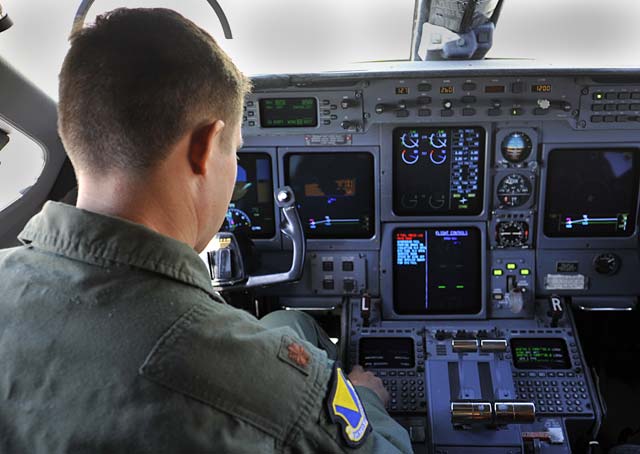
When asking a child what they wish to be when they grow up, a variety of responses may arise: a doctor, firefighter, ice skater or veterinarian, for example. For one 76th Airlift Squadron pilot, his interest in flying started at a young age.
Maj. William Dabney, 86th Airlift Wing Inspector General chief of wing readiness and 76th AS C-37A Gulfstream V and C-20H Gulfstream IV pilot, was strongly influenced in his decision to become a pilot. Dabney’s father was a helicopter pilot in the Army, and his grandfather was a Republic P-47 Thunderbolt pilot in the Army Air Corps just after World War II. These affiliations sparked his desire to attend the Air Force Academy, he said.
“It wasn’t until I started seriously considering going to the Air Force Academy that I started to look at flying for the military,” Dabney said. “My decision to go to the academy was strongly influenced by my desire to be a pilot.”
In 2005, Dabney graduated from pilot training in Del Rio at Laughlin Air Force Base, Texas. Shortly after, he was stationed at Altus Air Force Base, Oklahoma, then McChord Air Force Base, Washington, before arriving at Ramstein.
“At the 76th Airlift Squadron, I am an aircraft commander for the C-37A Gulfstream V and C-20H Gulfstream IV,” he said. “We perform distinguished visitor airlift, specifically, my airframes are tasked to the Africa Command commander, but we fly typically in Africa and Europe. We help facilitate high-level meetings and DV visits around Europe; wherever the DVs need to go, we’re here to facilitate that in a safe, secure and reliable transport. We take our job seriously and are very professional with what we do. We are the executive airlift for Europe as far as Air Force goes.
“I came into the Air Force to fly,” Dabney continued. “Particularly in this unit, we get to fly in Africa a lot, and it can be very challenging. I think that challenge is why I like that part of my job. It tests the things I know and learn.”
Dabney has not only been able to experience flying. Last July, he was given the opportunity to work for the inspector general. This allowed him to communicate and work side-by-side with other Airmen of different professions. The experience he gained from the IG office will help him in the future when he returns to the 76th AS.
“I was recommended by my squadron commander for the IG job,” Dabney said. “We really like to have career broadening rather than just being a guy who flies all the time. It was a job outside the squadron and something I had never done. I had no readiness experience at all, and I went from that to being the chief of readiness.
“As the chief of readiness, we’re involved with all aspects of the readiness program for the wing and installations — things like emergency management, police, firefighter and accident response,” he continued. “We validate and test the wing’s ability to respond to those kinds of events as well as the wing’s readiness to deploy.”
As part of the IG, Dabney is able to observe how different units work together to complete the mission. By understanding how they function, he is able to tailor his test scenarios to their routines. By running these scenarios, he can inform the commander about their readiness and prepare responders for real-life occurrences.
“We have the freedom to take a requirement given to us, such as test emergency responders, and create a scenario and then test it,” Dabney said. “We have to know how the fire department responds, for example, so we can make it realistic. This is a different side of the mission I didn’t get to experience on the other side of the flightline.”
With just over a year of experience working for the IG, Dabney returns to the squadron to get back to his passion: flying. With a new understanding of how the mission works as a whole, he can see how his career fits into the equation.
“My big take away from the IG has to do with the new inspection system,” he said. “With the new inspection system, there is an emphasis to expose and document your flaws and shortcomings rather than hiding them by putting window dressing on them when being inspected. Exposing your weaknesses and shortcomings helps the unit grow and gives commanders an honest look at how capable and compliant a unit is and the areas that need to be addressed and solidified. I think this philosophy is what I’ll take back to the 76th and emphasize both at the organizational level and the individual.
“For the Airmen at the 76th and for me as a pilot, I think the philosophy carries over that you can only know how strong you are by (knowing) what your weaknesses are,” he continued. “Furthermore, you can only get stronger by knowing your weaknesses, addressing them and holding yourself or your unit accountable.”
The sky’s the limit when it comes to the future. Dabney could have become an immeasurable number of things, and he chose to follow his dream as a pilot in the footsteps of his predecessors. Though his service in the IG office may be coming to an end, the lessons he learned will follow him back to the 76th AS as well as in his future endeavors.


